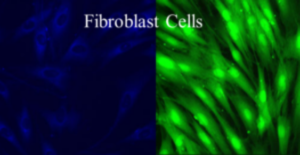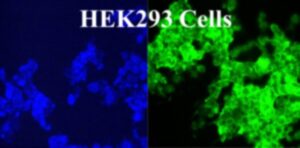HEK 293 cells are popular for their ease of growth and transfection (HEK293 Transfection Kit), making them a common cell culture in cancer research. In addition, high transfection efficiency of HEK293 cells produces exogenous proteins or viruses for pharmaceutical and biomedical research purposes. HEK-293 cells are useful for many transfection experiments, particularly the propagation of adenoviral-based and retroviral-based vectors.
Origins of the HEK293 Cell Line
HEK293 is a cell line derived from human embryonic kidney cells grown in tissue culture. They are also known, more informally, as HEK cells. This particular line was initiated by the transformation and culturing of normal HEK cells with sheared adenovirus 5 DNA. The transformation resulted in the incorporation of approximately 4.5 kilobases from the viral genome into human chromosome 19 of the HEK cells. The line was cultured by scientist Alex Van der Eb in the early 1970s at his lab at the University of Leiden, Holland. The transformation was executed by Frank Graham, another scientist Van der Eb’s lab who invented the calcium phosphate method for transfecting cells. The source of the cells was a healthy aborted fetus of unknown parenthood. The name HEK293 is thusly named because it was Frank Graham’s 293rd experiment.
The type of kidney cell that the HEK293 cell line came arose from is unknown and it is difficult to conclusively characterize the cells post-transformation since adenovirus 5 could have significantly disrupted cell morphology and expression. Also, embryonic kidneys are a heterogeneous mix of almost all the types of cells present in the body. In fact, it has been speculated by independent researchers, including Van der Eb himself, that the cells may be neuronal in origin. Although theoretically possible, most cells derived from an embryonic kidney would be endothelial, epithelial or fibroblast cells. Neuronal origin is suspected due to the presence of mRNA and gene products typically found in neurons.
Today, HEK293 cells are frequently used in cell biology and biotechnology, second only to HeLa, the first human cell line. Around establishment of HeLa in 1951, scientists were reluctant to accept and use human cell lines out of concern for an oncogenic agent in them. This concern, along with the known ability of animal cell lines to grow rapidly and yield a high amount of proteins, gave scientists reason to favor animal cell lines over human cell lines when producing recombinant proteins. However, advances in technology since then have allowed for an increase in human cell line use. One advantage of human cell lines is that they are able to produce proteins most similar to those that humans naturally synthesize. Now there are approved recombinant biotherapeutic products produced from HEK293 and other human cell lines.
HEK293 and its derivatives are used in a wide range of experiments, including signal transduction and protein interaction studies, rapid small-scale protein production, and biopharmaceutical production. HEK293 cells easily grow in suspension serum-free culture, reproduce rapidly, and produce high levels of protein, which explains why they have been widely used to produce research-grade proteins for a number of years.


Copyright picture from altogen.com. Reproduced with permission from Altogen Biosystems.
Expression in HEK293
- Muscarinic acetylcholine receptor M3
- Corticotrophin releasing factor type 1 receptor
- Transient receptor potential TRPC1, TRPC3, TRPC4, TRPC6
- Sphingosine-1-phosphate receptors EDG1, EDG3 and EDG5
HEK293 Cytogenetics
HEK293 is a hypotriploid cell line with modal chromosome number of 64, which occurs in 30% of cells. Cells with higher ploidies occur less frequently at a rate of 4.2%. HEK293 cell lines display some cytogenetic instability.
Links
GLP-compliant Cell Banking services
HEK293 Cell │ HEK293 Cell Culture │ Transfection Information │ HEK293 Transfection Reagent